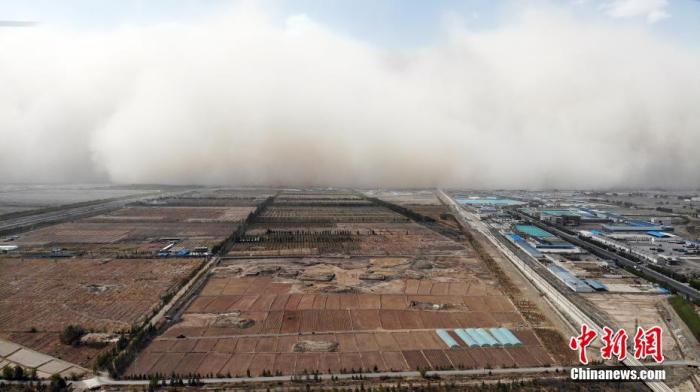Chinanews.com, April 29th. Jia Xiaolong, deputy director of the National Climate Center, said on the 29th that it is expected that in May, most of my country's northwestern region to the west of Inner Mongolia will have less precipitation, high temperatures, and cold air will be active in stages, and it may still occur in northern regions In sandy weather, pay attention to the impact of sandy weather on production and life.
Data map: Sandstorm attack.
(UAV photo, unrelated to the text and image) Photo by China News Agency reporter Gao Zhan
The China Meteorological Administration held a press conference on the 29th. At the meeting, a reporter asked questions about how the number and intensity of sandstorms in my country this spring compared to recent and normal years?
What is the main reason for this phenomenon?
Will there be dusty weather in May?
In this regard, Jia Xiaolong said that since this spring, the average number of dust-raising days and above in northern my country has been 1.7 days, the most since 2011 in the same period.
Since the spring of this year, there have been 5 sand-dust weather (floating sand and above) in northern my country, including 3 sand-dust storms, but 2 strong sand-dust storms, slightly more than normal (1.1) in the same period of the year.
The intensity of sand and dust weather in March 2021 is relatively strong.
Jia Xiaolong said that there are generally several conditions for the formation of sandstorms: bare ground, dryness and little rain, plus the influence of cold air activities.
Once the conditions are very favorable, sand and dust will be rolled up to form bad weather.
There are two main reasons for the sand and dust weather since this spring:
First, the temperature in Mongolia and northwest my country has been significantly higher recently. From the winter to the early spring of last year, most of Mongolia and northwest my country had less precipitation than normal in the same period, and there was less snow cover on the surface.
A wide range of bare ground provides sand source conditions for the occurrence of sand and dust weather.
Second, since mid-March, the Eurasian mid-high latitude circulation has undergone a phased adjustment, the Siberian high pressure has strengthened, the Mongolian cyclone has developed and moved eastward rapidly, and the mid-latitude circulation in Asia has experienced a phased meridian circulation. The lower layers are all affected by the northwest wind anomaly, which provides favorable dynamic conditions for the transportation of sand and dust from the source to the southeast, forming a relatively obvious sand and dust weather process, which affects a large area of northern my country.
"It is expected that in May, most of my country's northwestern region to western Inner Mongolia will have less precipitation, higher temperatures, and active cold air in stages. Sand and dust weather may still occur in the northern region. Pay attention to the impact of sand and dust weather on production and life." Jia Xiaolong Weighed.

